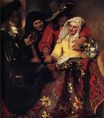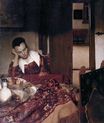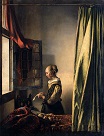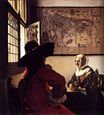Johannes Vermeer - Girl Reading a Letter at an Open Window 1657
 |
 |
 |
 |
 |
 |
 |

Girl Reading a Letter at an Open Window 1657
83x64cm oil/canvas
Gemäldegalerie Alte Meister, Dresden, Germany
The image is only being used for informational and educational purposes
<< Previous G a l l e r y Next >>
From Wikipedia, the free encyclopedia:
In Vermeer, 1632–1675 (2000), Norbert Schneider indicates that the open window is on one level intended to represent "the woman's longing to extend her domestic sphere" beyond the constraints of her home and society, while the fruit "is a symbol of extramarital relations." He concludes that the letter is a love letter either planning or continuing her illicit relationship. This conclusion, he says, is supported by the fact that x-rays of the canvas have shown that at one point Vermeer had featured a Cupid in the painting. This putto once hung in the upper right of the piece before, for whatever reason, Vermeer drew the draperies over it.
The draperies themselves, hanging in the right foreground, are not an uncommon element for Vermeer, appearing in seven of his paintings. Even more common, the repoussoir appears in 25, with Girl Reading a Letter at an Open Window, one of three which feature a rug-covered table or balustrade between the figure and the viewer. It was the last painting in which Vermeer featured this device.
This painting and Officer and Laughing Girl represent the earliest known examples of the pointillé (not to be confused with pointillism) for which Vermeer became known. John Michael Montias in Vermeer and His Milieu (1991) points out the "tiny white globules" that can be seen in the brighter parts of both paintings, including the still life elements of both and the blond hair specifically in this work. This use of light may support speculation among art historians that Vermeer used a mechanical optical device, such as a double concave lens mounted in a camera obscura, to help him achieve realistic light patterns in his paintings.